
SciencebiologyBiotechnology
Yong Ju Lee Grows Mycelium Pavilion Using Robotic Printing in Seoul.
KE
Kevin White
5 hours ago7 min read4 comments
In a groundbreaking fusion of biology and robotics that feels ripped from the pages of a sci-fi novel, architect Yong Ju Lee has unveiled a pavilion in Seoul grown from mycelium and fabricated using industrial robotic arms. This isn't mere construction; it's a form of guided biosynthesis, where each intricate panel of the structure is birthed inside a customized 3D-printed mold.These molds, shaped with the inhuman precision of robotics, are then filled with a selected substrate—the nutrient-rich bed—that acts as the launchpad for the mycelium, the root-like network of fungi, to colonize and thrive, ultimately forming a solid, living building component. This project sits at the thrilling convergence of synthetic biology and advanced manufacturing, a field rapidly moving from laboratory curiosity to tangible application.The use of mycelium in architecture isn't entirely new; pioneers like Phil Ross and studios like The Living have previously demonstrated its potential with smaller-scale installations. However, Lee's work represents a significant evolution, scaling up the process and integrating it seamlessly with high-tech robotic fabrication.This methodology tackles one of the key challenges in bio-based materials: achieving complex, load-bearing geometries with consistent material properties. The robotic arms ensure each mold is perfect, eliminating human error and allowing for designs that would be impossible to craft by hand, while the controlled growth of the mycelium within these molds guarantees structural integrity.The implications are staggering, pointing toward a future where our buildings are not built but grown, significantly reducing the carbon footprint associated with traditional concrete and steel. Imagine a world where urban development is a symbiotic process with nature, where structures can self-heal minor cracks or even be composted back into the earth at the end of their life cycle, creating a truly circular economy.This isn't just about sustainability; it's about reprogramming our relationship with the built environment. Experts in biomimicry and material science are watching these developments closely.Dr. Elena Martinez, a leading researcher in bio-hybrid materials at the MIT Media Lab, who is not directly involved in this project, notes, 'What we're seeing is the maturation of a new design paradigm.The integration of computational design, robotics, and biological growth allows us to engineer at the organism level. We're no longer just assembling parts; we're curating an ecosystem.The next frontier will be embedding functionalities directly into the material—perhaps mycelium that can bioluminesce or filter air pollutants as it grows. ' Of course, the path from a pavilion to a high-rise is fraught with hurdles.Regulatory frameworks for living building materials are virtually non-existent, and questions about long-term durability, fire resistance, and moisture control in varied climates remain active areas of research. Furthermore, the scalability of the production process to meet the demands of global construction is a monumental challenge.Yet, the Seoul pavilion stands as a powerful proof-of-concept, a beacon of what's possible when we stop fighting nature and start collaborating with it. It challenges the very definition of a factory, suggesting a future where our production facilities are more akin to humid, controlled greenhouses than loud, smoky industrial plants. As we stand on the brink of a biotechnological revolution in medicine with CRISPR and in materials with projects like this, the work of visionaries like Yong Ju Lee is not just designing buildings; it's coding the DNA of our future cities.
#mycelium
#robotic 3D printing
#bio-integrated architecture
#sustainable design
#pavilion
#Seoul
#featured
Stay Informed. Act Smarter.
Get weekly highlights, major headlines, and expert insights — then put your knowledge to work in our live prediction markets.
Related News
© 2025 Outpoll Service LTD. All rights reserved.
